Amped Wireless R20000G, SR20000G, and UA2000: Routers, Repeaters, and Adapters (Oh My!)
by Jarred Walton on June 23, 2012 12:00 AM EST- Posted in
- wireless
- Networking
- 802.11n
- Amped Wireless
Test Location A Results: Maximum Performance
As described on the previous page, our first location is our best-case scenario with the router and wireless adapters in the same room spaced around five feet apart. No other wireless activity is present on the network, and each test was repeated at least ten times. There’s signaling overhead with all wireless networking, so whereas I’ve seen Gigabit Ethernet hit 115MiB/s (965Mbps, or 96% utilization of the available bandwidth), for wireless networking even 70% utilization of the theoretical bandwidth would be very impressive. We didn’t get anywhere near that, unfortunately, although at least we managed to eclipse 100Mb Ethernet speeds for some of the results.
Before we get to the throughput results, it’s interesting to look at the signal quality with the various adapters and routers. I apologize for the sorting of the charts here, but RSSI is measured in negative decibels, with higher (e.g. closer to 0) values being better. Our graphing engine does weird things with negative numbers, so I’ve dropped the minus sign; the result is that numbers closer to 0 (lower in this case) are better. The second minor complaint with our graphing engine is that with multiple series defined, sorting can be a bit chaotic, so I’ve elected to sort alphabetically by router name on most of the charts you’ll see. Keep in mind that there are two comparisons you can make with each chart: how the routers stack up against one another, and how the wireless adapters fare.
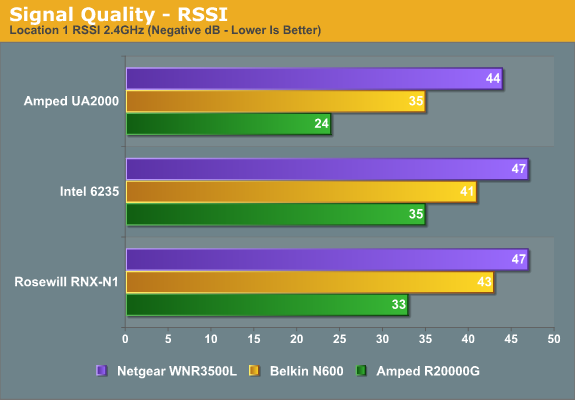
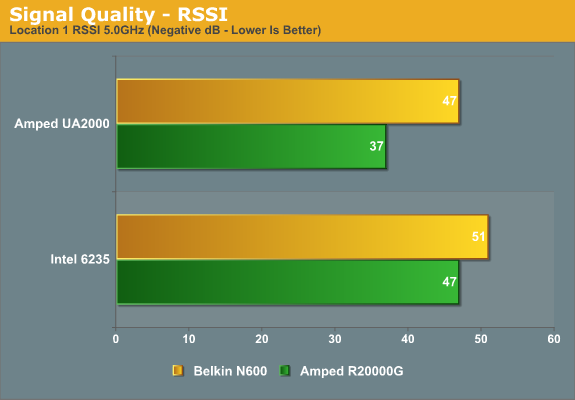
Starting with our first two charts, the Amped Wireless devices score two clear victories. On the one hand, the R20000G router has better RSSI, beating the other routers by anywhere from 4 to 20 dB. (I should note that these RSSI values are approximate, as there’s a bit of fluctuation when measuring with inSSIDer—I took the average RSSI over a one minute period, rounded to the nearest dB.) The second comparison is between the adapters, and again Amped acquits itself well with the UA2000; RSSI is only 3 dB better than the other two adapters when connected to the Netgear router, but it’s 4-8 dB better on the Belkin and 9-11 dB better on the R20000G. If signal quality is any indication of wireless performance, at least at our first test location the Amped router and adapter should have a decent lead in network throughput. We’ll break the throughput measurements into 2.4GHz and 5GHz sections and deal with those separately.
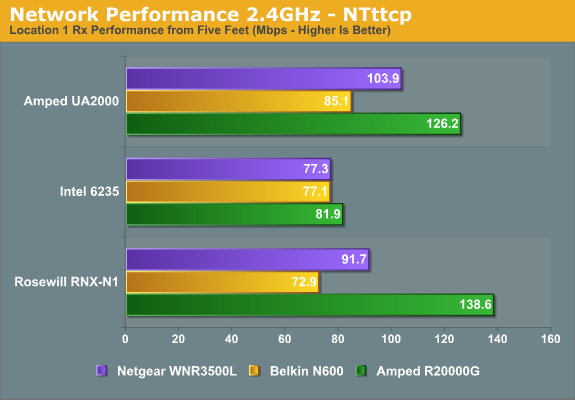
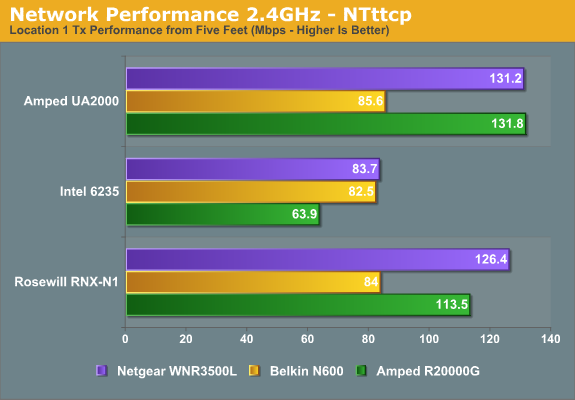
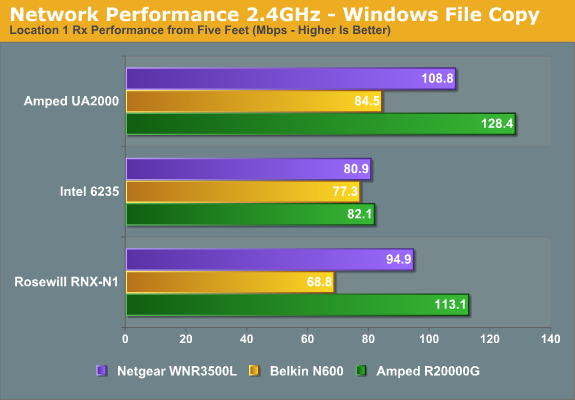

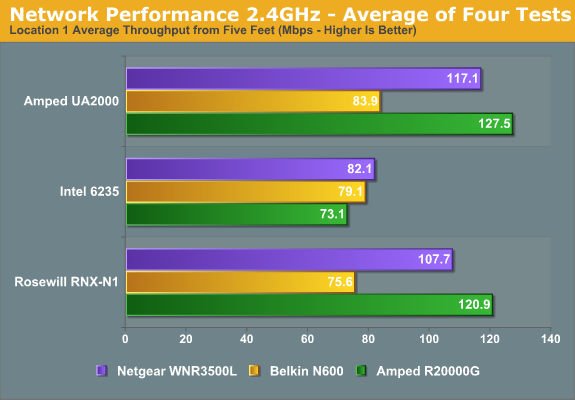
Using the 2.4GHz spectrum, things don’t quite fall out as the RSSI numbers would lead us to expect. On the router side of things, the R20000G typically at least matches the other two routers or takes an outright lead, regardless of which adapter we use. There are two exceptions: one is in the NTttcp Tx speed with the Rosewill adapter, where the Netgear actually comes out ahead; the second is that the Intel 6235 adapter has relatively poor rates for both Tx tests with the R20000G.
Looking at the average performance for all four tests, the R20000G is the fastest router with two of the adapters and the slowest when paired with the Intel 6235 (though that’s caused by the low Tx rates, as Rx rates are actually slightly higher than with the other two routers). Across the three adapters, the R20000G leads the Netgear by just 5% but takes a more significant 35% lead over the Belkin router.
There’s another interesting piece of information with the routers, and that’s the performance of the Belkin N600. Despite being capable of up to 300Mbps, the best result with the three adapters is only around 85Mbps. The reason appears to be related to the use of 40MHz channels; Belkin’s router is more neighbor friendly, so the presence of other (generally weak) 2.4GHz wireless signals causes the router to default to a 20MHz only channel (144Mbps max), and 85Mbps is roughly 60% utilization (about the most we usually see in practice with wireless networking).
Comparing the three adapters, Amped’s UA2000 again leads in most of the tests, often by a sizeable margin. The one test case where it comes in second is NTttcp Rx speed, where the lowly Rosewill adapter manages to score a win when paired up with the R20000G. In the other test cases, the UA2000 is at least as fast as the next closest adapter, with up to twice the throughput of the Intel 6235 on the Tx testing. There’s no equivocating necessary this time: the UA2000 delivers better average performance across our three test routers. It’s 8% faster than the Rosewill adapter (which incidentally also uses a Ralink chipset) and 40% faster than the Intel 6235. On a similar note to the Belkin router, it also appears that Intel’s 6235 drivers are more neighbor friendly, as the 6235 never locked onto a 40MHz connection even in our best-case test scenario. Now let’s see what happens with a 5GHz connection.
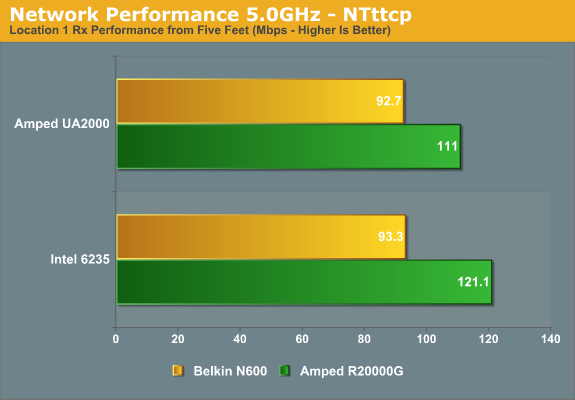
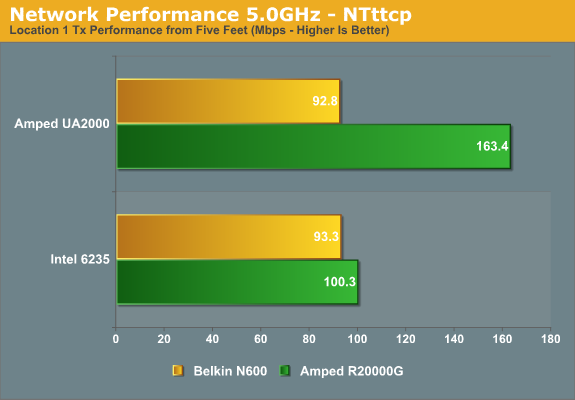
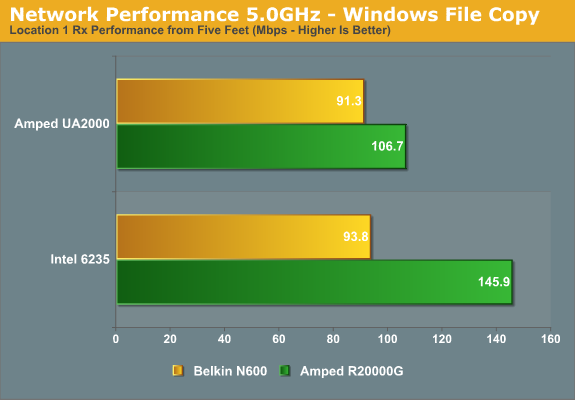
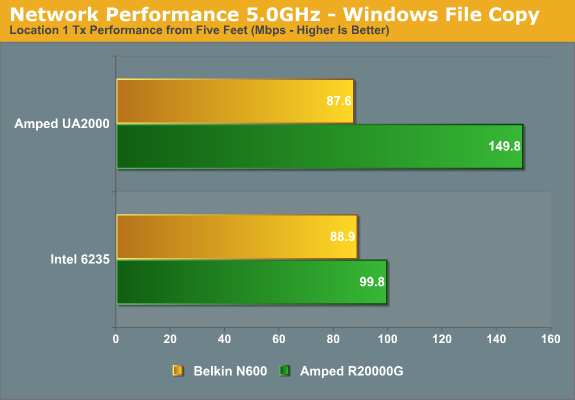
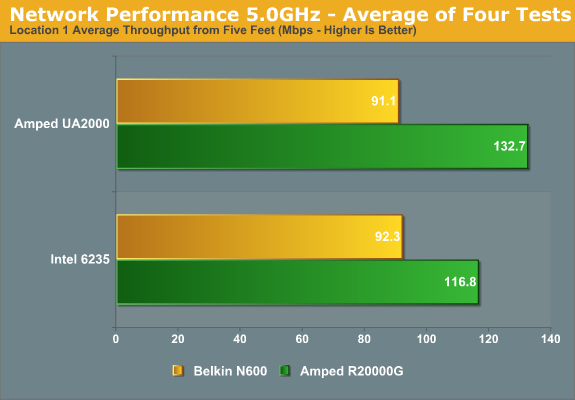
This time we only have two routers and two adapters to look at, since the Netgear router and Rosewill adapter are both limited to 2.4GHz operation. Looking at the router results, again the R20000G takes a healthy lead over the Belkin router, leading in throughput by anywhere from 7.5% (NTttcp Tx with the Intel 6235) to as much as 75% (NTttcp Tx with the UA2000). On average, the R20000G delivers 35% better throughput compared to the Belkin N600—45% better using the UA2000, or 26% better with the Intel 6235. The Belkin also does connect with 40MHz channels this time, but even with the wider bandwidth allotment, performance never quite makes it up to 100Mb Ethernet speeds, indicating Belkin’s router isn’t one of the best offerings out there. Obviously, we’re only dealing with one point of comparison and I expect some of the better routers out there (ASUS RT-N66U, Apple Airport Extreme, Linksys E4200, etc.) would deliver comparable if not better performance, particularly when teamed up with a 3x3:3 MIMO adapter. Still, the R20000G delivers very good throughput for close proximity connections.
Switching over to the adapter comparisons, the UA2000 appears to be running into bottlenecks with the Belkin router, resulting in performance that’s basically tied with the Intel 6235. Of note is that where the Intel 6235 refused to use a 40MHz connection on 2.4GHz, it’s more than happy to grab a 300Mbps connection this time. When we shift over to the R20000G, we get two different stories. On the one hand, the UA2000 has Tx rates that are 50-65% faster than the Intel 6235, which is impressive; what’s not so impressive is that Intel turns the tables on Rx rates and leads the UA2000 by 10-35%. I’m not sure which one would be more important for me in practice, but I’d probably err in favor of Rx rates, as I’m more likely to be copying/receiving large amounts of data over the network as opposed to sending/transmitting data. (As an example, I could be streaming a movie from a NAS or similar system to my laptop, but I typically wouldn’t be sending a movie back to the NAS/server.) Average throughput across all four tests still favors the UA2000 over the 6235 by 14%, but the better Rx rates with 6235 makes this more of a tossup.










28 Comments
View All Comments
tonyt87 - Saturday, June 23, 2012 - link
Cisco/Linksys switched to Marvell chipsets with the 4200v2 and 4500, the original 4200 uses Broadcom.arthur449 - Saturday, June 23, 2012 - link
I used the SR10000 repeater recently to provide a solution for weak / non-existent signal anywhere beyond the far end of their apartment where they kept all of their computer equipment. I positioned the repeater in a higher/more centralized location and they get great reception to it.This is after I made absolutely sure they could not stand to run an ethernet cable/use powerline networking or reposition their overpriced fruit-branded wireless router to a new (higher) location rather than keeping it beneath a desk. Apparently, they have a fear of wires, yet hate unreliable connections. *shrug*
Anyhow, the repeater gives them reception in the places where it was simply impossible and didn't create any additional unsightly cords.
I've only run into one problem: When the fruit-branded wireless router loses power, the SR10000 repeater freaks the *$(@ out and does not automatically reconnect to the fruit-branded network when it comes back online. While I'm certain a static IP for the wireless repeater would fix this, the client can't remember the fruit-branded router's admin password and a full reset is strictly forbidden.
ShinyLeaf - Saturday, June 23, 2012 - link
I have this same repeater (SR10000) and a non-fruit branded router with the same problem. I tried to switching to static IP and it doesn't fix the problem.Anytime the router / access point loses power, or the repeater loses the wireless connection for a sec (microwave interference, etc), the repeater just craps out and I need to unplug/plug-in to get it to reconnect.
Probably a firmware issue, but there hasn't been any update in 6 months.
irev210 - Saturday, June 23, 2012 - link
There is a bigger comparison over at smallnetbuilder - not really that impressive:http://www.smallnetbuilder.com/wireless/wireless-r...
Pretty sad, really.
mevans336 - Saturday, June 23, 2012 - link
I read the Smallnetbuilder review and came away with the same opinion.Their "coverage" claims reek of sleazy marketing hype to confuse the average consumer. "Oh look, we cover 10,000 bajillion feet!" when in actuality, their coverage is no better than any other wireless router on the market.
JarredWalton - Saturday, June 23, 2012 - link
Note that the smallnetbuilder review is for the R10000G, so there's no 5GHz support. Looks like 2.4GHz support is roughly the same, given our different test locations, though I was able to connect at the worst-case location without trouble. Also note that smallnetbuilder only tests with one wireless adapter on the newer routers, the Intel Ultimate-N 6300. If you couldn't tell, in my experience the choice of wireless adapter can make a very large difference in some tests.That's the hard thing with wireless testing: change any variable (router, adapter, time of day, weather, drivers, test laptop, positioning, etc.) and you can't guarantee the results are directly comparable. Ideally, I'd want to do a large roundup of at least ten different wireless adapters and test those with a couple different routers -- and if you really want to be apples-to-apples, you'd need to test them all in the same laptop or use a PCI card. From that, you can determine which adapters work best in general. Then take the top three adapters and test every router with those adapters, and you should be able to determine which routers work the best.
That, incidentally, is a TON of work, assuming you can even get all the hardware to test with. Given the amount of testing, you'd be looking at different adapters/routers on different days with different weather, so you'd probably need to test each adapter/router combination at least twice (e.g. several days apart) to verify there's no massive change in performance, and if there is then test a third time. I'm not sure if there's enough value in doing that much testing, so the result is more "rough estimate" type reviews, like what I've done.
Olaf van der Spek - Saturday, June 23, 2012 - link
Isn't DD-WRT (development) dead anyway?JarredWalton - Saturday, June 23, 2012 - link
I don't believe so; you can get a build dated March 15, 2012 for the ASUS RT-N66U for example. There are also similar tools out there (OpenWRT, MyOpenRouter--Netgear only on that one). I think it would be best to state that the set of new hardware being supported is very limited, so if you want DD-WRT support you need to shop with that intention.Olaf van der Spek - Sunday, June 24, 2012 - link
Latest stable release has been v24 SP1 (Build10020) and Latest development release has been v24 preSP2 (Build13064) for years.A build dated March 15, 2012 doesn't mean that much.
Is there a comparison between DD-WRT and OpenWRT available somewhere?
blindbox - Monday, June 25, 2012 - link
You should take a look at their source revisions. For example, OpenWrt just hit their 32000th revision about a month ago.Anyway, here's where you can see progress.
OpenWRT https://dev.openwrt.org/browser
DD-WRT http://svn.dd-wrt.com/browser
Last commit for OpenWRT was 20 hours ago. For DD-Wrt, it was 50 minutes ago.
DD-WRT does provide snapshot builds but I don't know why they've stopped releasing stable builds altogether. OpenWrt at least has their somewhat yearly stable releases.